Shopping a la Uzbekistan
Uzbekistan is like a country from the Tale of Thousand and One Nights, with its countless mosques, madrasas and mausoleums glimmering with blue mosaics. Apart from visiting incredible monuments (more on this topic in other posts) you absolutely must find some time for exploring bazaars and doing some shopping Going shopping in cities of the Silk Route such as Samarkand, Bukhara or Khiva is pure pleasure as well as great opportunity to see at close hand the everyday life of the citizens of Uzbekistan and feel the atmosphere of the city.
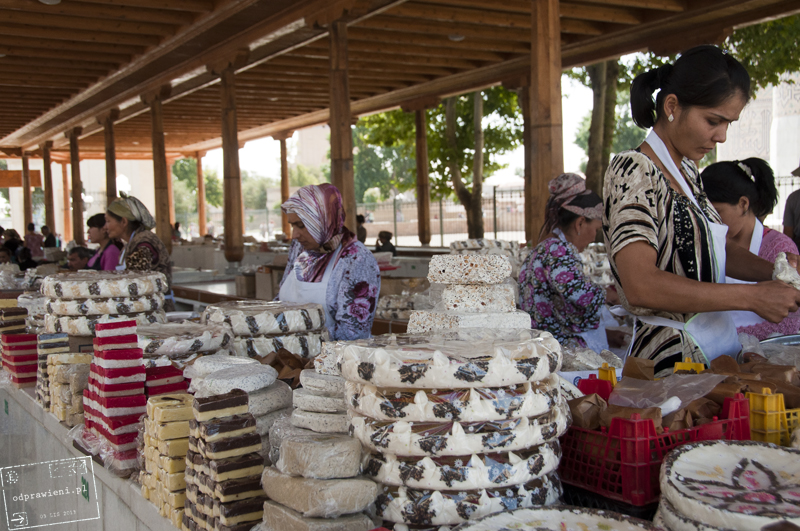
Delicacies at a bazaar in Samarkand. The city is renowned for its homemade nougats, chocolates and incredibly good halvahs. The products can be tasted on the spot. Remember to haggle – “ustupka” is a key word!
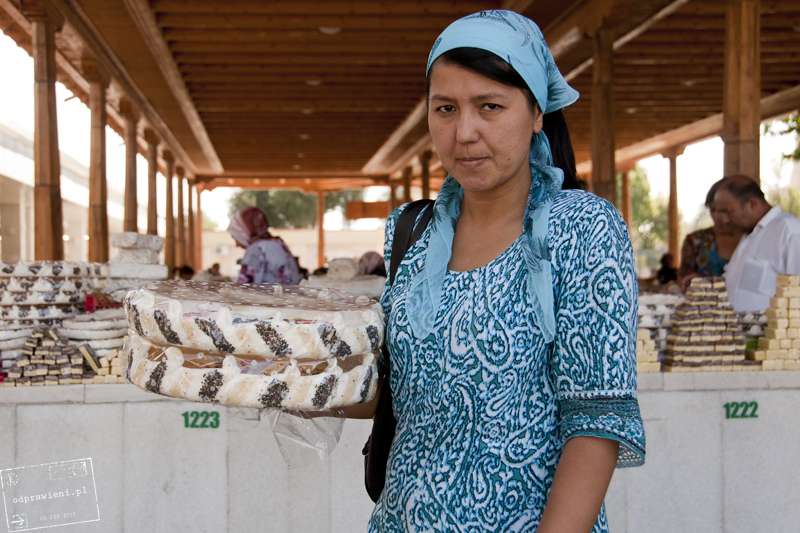
What’s worth buying in Uzbekistan?
First and foremost, the wonderful handicraft, which is here not only beautiful but also relatively cheap. Many Uzbek families have been dealing with crafts for generations. Nowadays the Uzbek pottery, silk carpets and wood articles are gaining fame and recognition all around the world.
Pottery
Huge serving platters, chargers, plates, cups, mugs or whole sets of small colourful pieces of art are a showcase of Uzbekistan and one of its most beautiful export commodities. Every region of Uzbekistan has its own school of ceramics with its own unique style and characteristic colour scheme. The region most famous in terms of its ceramics is Rishtan, a small town in the Fergana Valley, located half way between Kokand and Fergana, near the border with Kirgizstan. It’s a real cluster of ceramics workshops with long tradition. The pottery that comes from that region is considered most valuable and beautiful.
JOIN OUR UNIQUE GROUP ON FACEBOOK ABOUT UZBEKISTANStrolling around the streets of Bukhara or Khiva, you’ll be fascinated by the beautiful plates, platters, bowls or cups spread out on pavements by sellers. These colourful ceramic fields look spectacular. If you want to buy some ceramic souvenirs, what we strongly recommend by the way, remember to protect it well during transport. These objects are after all really fragile and require strong packaging. If you decide to buy a lot of Uzbek pottery, you may consider sending it to Poland by post. We tested this solution and in our case it worked –every piece of ceramics we posted reached its destination safe, sound, and fast.
Wood articles
Carved wooden columns, that you’ll have a chance to see especially frequently in Bukhara and Khiva, are real wonders. Uzbek craftsmen are real masters in that field and they receive orders for their columns from all parts of the world. Admittedly, you can’t put such a column in your knapsack, but you can squeeze in wooden frames or characteristic wooden stamps for decorating bread. They will make excellent souvenirs.
Textiles
Here you also have a huge choice: tablecloths, pillowcases, suzanis –sizeable pieces of beautifully hand embroidered fabric, shawls, dresses and finally, the famous Uzbek silk carpets. It’s easy to check whether something is actually handmade. You just need to look at the reverse side of the fabric –if you see the characteristic knots and loose threads, you may be sure that it’s a genuine fine handiwork. You can buy something really nice for even 15$-20$.
The most famous and the best bazaars in Uzbekistan
Chorsu in Tashkent
One of the oldest and biggest bazaars in Central Asia, treated by the citizens as the heart of the city. Below the characteristic blue dome you may choose from a huge selection of spices, dried fruit and nuts, dried cheeses and other foodstuffs, while in the outer part of the bazaar you can buy fresh fruit and vegetables. There are relatively few souvenirs and handicraft. Vibrant place, full of various aromas (not always pleasant ), bustling, full of noisy and competitive sellers. The bazaar is located on Beruniy Street (Chorsu Metro Station) and it’s open every day from dusk till late afternoon.
Indoor bazaars in Bukhara
In Bukhara souvenir shops and stores selling handicraft are really ubiquitous but there are four greatest clusters of them. Although they are called bazaars, they are in fact small corners located at crossroads, creating characteristic passages. They date back to the 17th century and they’ve been in continuous operation since their erection. Due to the characteristic doomed roofs the bazaars are also called other names –trading domes or covered bazaars. The trading halls don’t receive much sunlight, what makes them pleasant shaded hiding places during heat waves. The stalls are beautiful and we absolutely recommend visiting them even if you don’t want to buy anything. The bazaars fit into the oriental atmosphere of Bukhara and I love to wander around them aimlessly.
The bazaar located closest to Lyab-i-Hauz is Taqi-Sarrafon trade dome, which is the smallest bazaar and a place where people have exchanged currencies from the ancient times. Several centuries later, when dollars achieved more favourable exchange rate on the black market, you could meet here money-changers and exchange currencies. Another doomed bazaar erected in the 17th century is Taki – Zargaron called the “Jewelers’ shopping arcade”. It’s the biggest covered bazaar where until today one may buy beautiful handmade jewelry and lots of other souvenirs.
Under the dome of Taki –Telpak Furushon you may find all kinds of headwear, especially the characteristic fur hats which are a specialty of this bazaar. The last authentic and still operating trading hall is Tim – Abdullakhan. It’s a covered bazaar with a unique feature –lack of a passage cutting it through. It was constructed in 1577 and it used to be known by the name Tim-i Kalan, what translates as the Great Market. It has been considered the centre of the famous silk trade in Central Asia for whole centuries. The bazaar was erected on the square plan, with blank walls devoid of decorations. Today it’s the best bazaar in the city if you want to buy handmade carpets, tablecloths or shawls.
Siyob Bazaar in Samarkand
This is the most atmospheric food bazaar, especially its section with sweets. You can buy here literally anything but the place number one is the part with sweets located under the wooden carved roof. Yet these tables loaded with homemade chocolates, nougats with incredibly varied additions, countless kinds of dried fruit and nuts and other delicacies form only one (and for me the best) part of the bazaar in Samarkand. A striking contrast to all those dainties is formed by a section with disgusting dried cheeses which come in various shapes: balls, butterflies, sticks, big rectangular blocks etc. The cheeses reek terribly but, thankfully, this is the only section of the bazaar that is closed in a separate room what prevents the smell from spreading all over the place. The Samarkand bazaar also has a separate section devoted to fruit and vegetables, which not only look but also taste great. Those peaches, figs and other marvels arranged in perfect rows literally beg you to eat them. A melon from Uzbekistan tastes incomparably better than the one you can buy in Poland, yummy! We can only hope that this deliciousness is not a result of pesticides used here without second thoughts
Urgut Bazaar
There are 3 bazaars in Urgut: Dehkan Bazaar, Maize Bazaar and the famous Urgut Bazaar which is most popular among tourists. It is located right next to the main road leading to Samarkand. You can buy there anything: clothes and footwear produced in Uzbekistan, cheap Chinese stuff, chapans (traditional coats worn by men), traditional suzanis, embroidered tablecloths, pillowcases and other textiles, festal turbans and many Uzbek delicacies. The Urgut Bazaar is unofficially considered among tourists as the best place in the country for buying all kinds of souvenirs (ceramics, suzanis, jewelry, carpets etc.). Prices here are much lower than in Samarkand or Bukhara, while the quality is not worse. Quite on the contrary –sometimes it’s even better. First of all, you obviously need to know how to haggle. The bazaar is open every day but the textile and jewelry “section” situated at the back of the main hall is open only on Sundays, Wednesdays, and sometimes also on Saturdays. We recommend visiting the place in the early hours of the morning when the choice is the greatest, crowd the smallest and, consequently, prices most favourable.
How to get there? A shared taxi from Samarkand will cost you around 8000Som, while Marshrutka costs 4000Som and leaves at the stop located at the junction of Dagbet and Registan Streets.
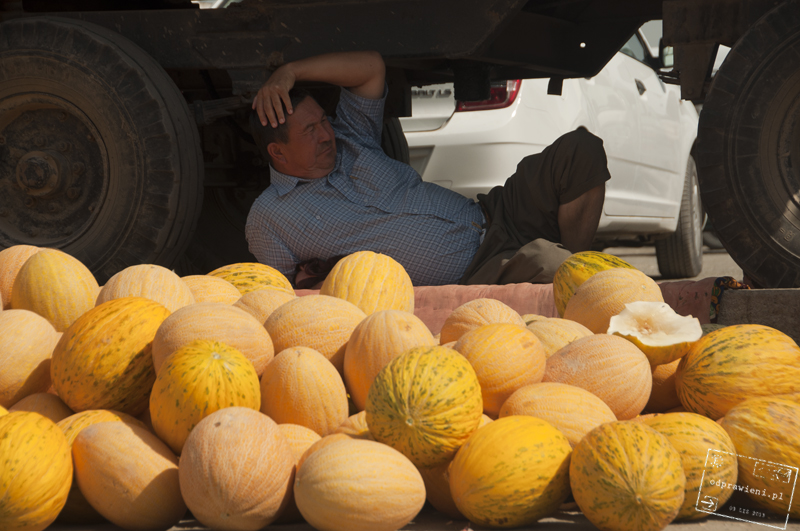
Zdjęcie powyżej: Melony i znudzony sprzedawca
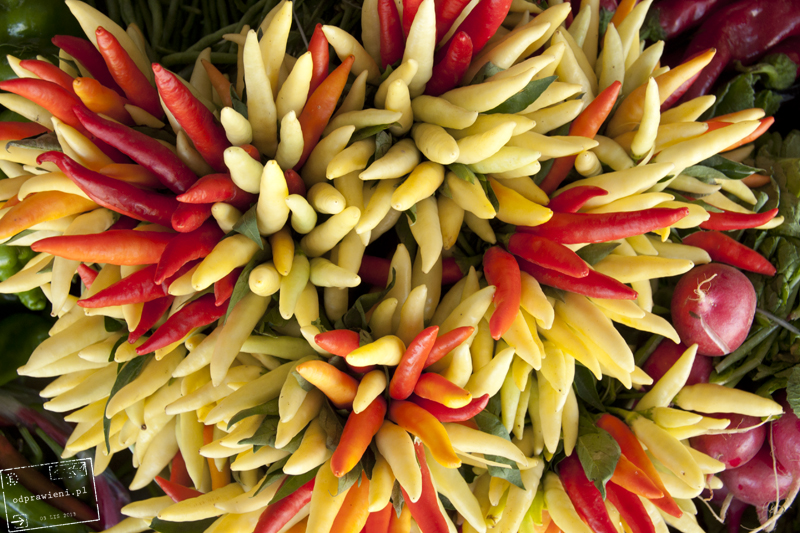
O
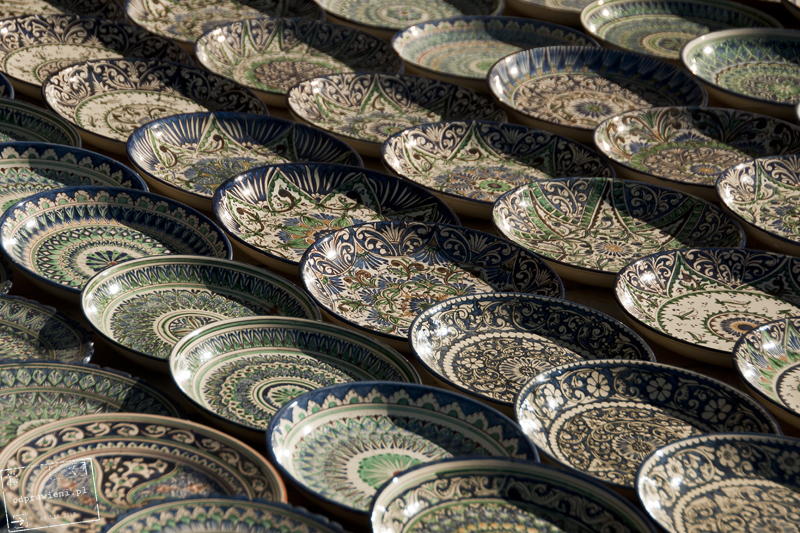
Above: Hand-painted pottery, Khiva; below: Father and son carving a wooden column, Khiva.
Below: Father and son carving a wooden column, Khiva.
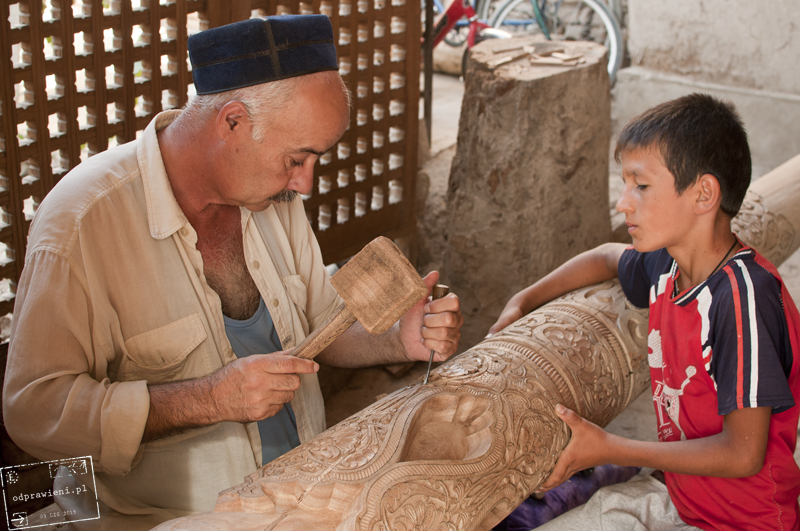
The best thing is that all articles are produced literally in front of us. Just wander into one of the side streets and you’ll see a whole family working together. You can buy wooden frames, bowls, bookshelves but the real masterwork are chess! There is also furniture for sale and other XXL-sized articles such as doors or columns, which are very characteristic for Khiva and decorate many of its buildings and hotels.
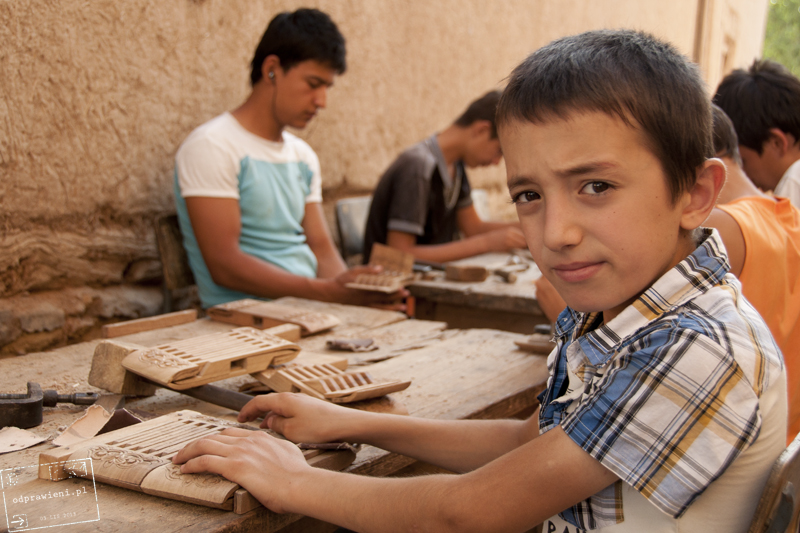 Production of wooden book stands; below: Seller of hand woven and embroidered tablecloths, Khiva.
Production of wooden book stands; below: Seller of hand woven and embroidered tablecloths, Khiva.
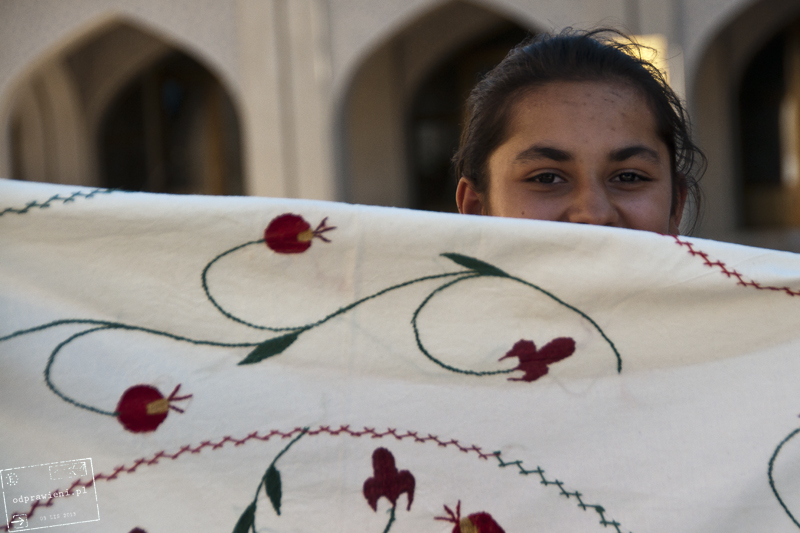
In Uzbekistan men often wear loose white shirts with embroidered details. We decided to buy a few such shirts but we couldn’t find the right size; either the sleeves were too long or the shirt too tight or too short. Finally the saleswoman grabbed the tape measure, opened a notebook and started to measure my models. The shirts were ready in 3 hours! The tailoring service wasn’t extra paid and the shirts fitted us perfectly
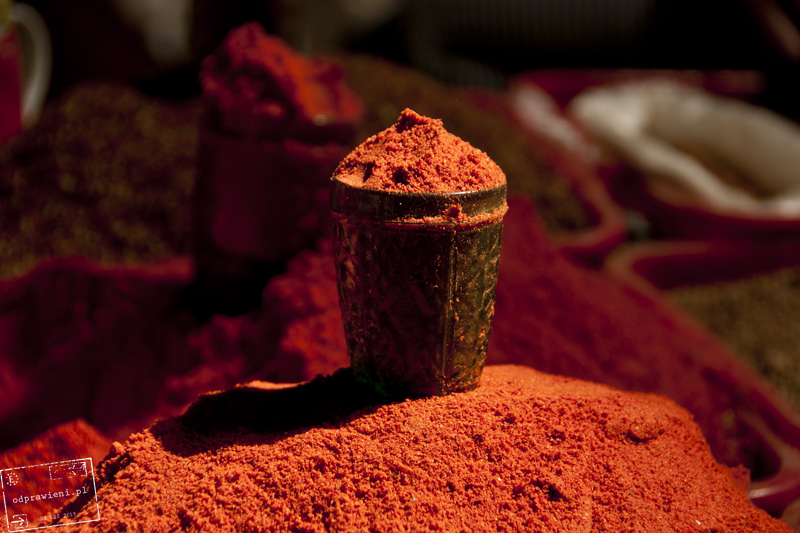
Buy spices! They are cheap, they’ll survive the journey and chili or cumin sold in Poland can never compare to them.
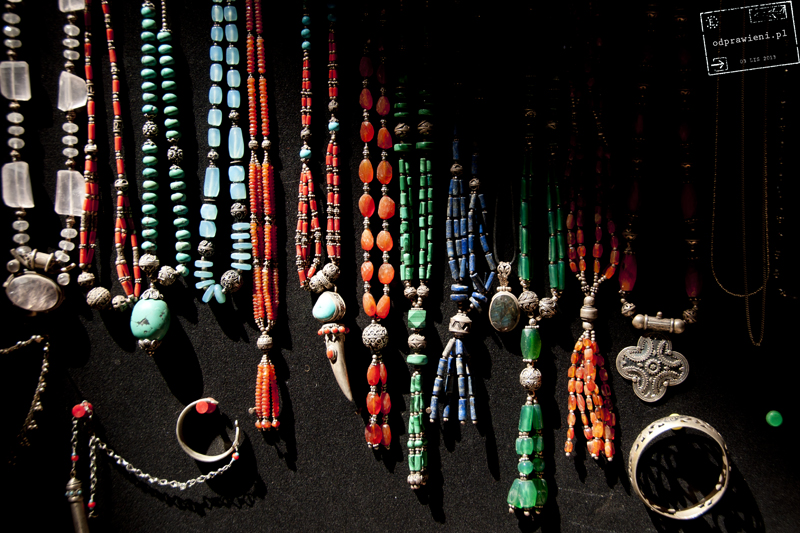
Tourists with fat wallets may purchase the famous Uzbek carpets. A carpet with your own image might also be a great treat. The photo shows a woman weaving a carpet with a portrait of a Russian “dignitary” –you may already see a tie. Price –”only” 1500 $
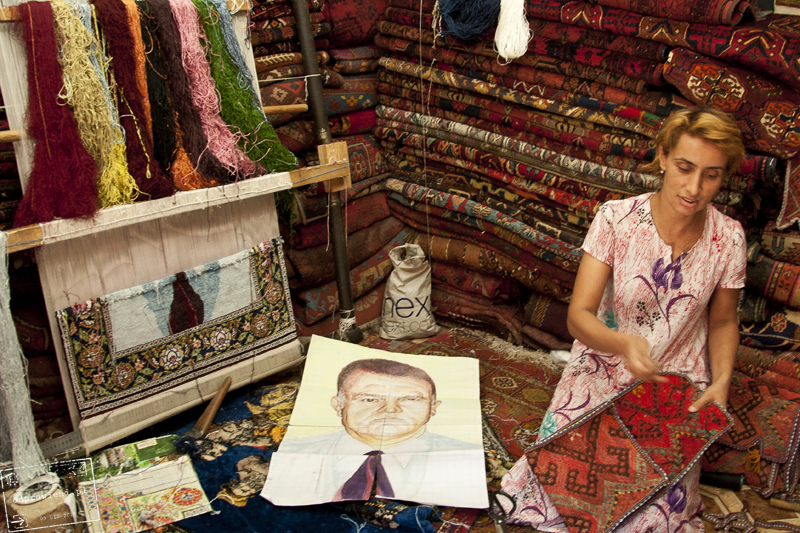
K
GO TO MEET THE UZBEK GALLERYK
GO TO UZBEKISTAN...ON THE SILK ROAD GALLERY


Pingback: Silk Factory – A Gem of Fergana Valley! - odprawieni.com